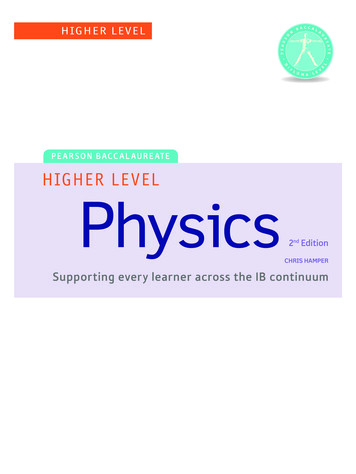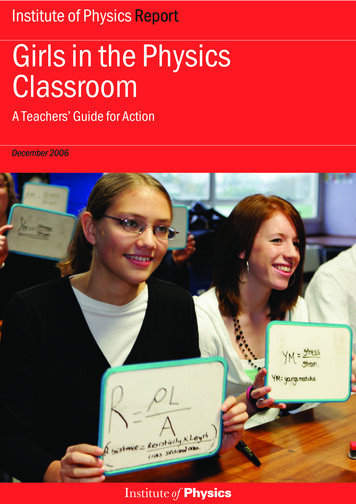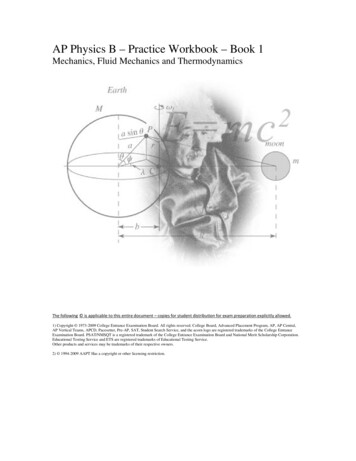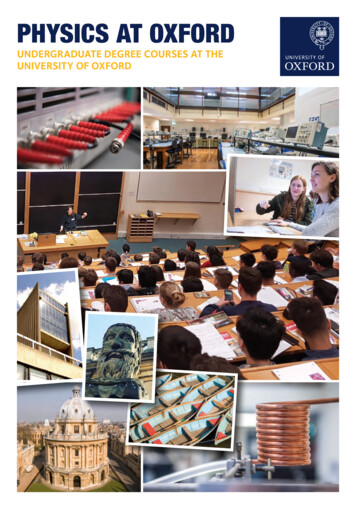
Transcription
HIGHER LEVELP E A R SO N B ACC A L AU R E AT EHIGHER LE VELPhysics2nd EditionCHRIS HAMPERSupporting every learner across the IB continuumA01 IBPH SB IBGLB 9021 PRE.indd 122/09/2014 13:23
Published by Pearson Education Limited, Edinburgh Gate, Harlow,Essex, CM20 2JE.www.pearsonglobalschools.comText Pearson Education Limited 2014Edited by Gwynneth DrabbleProofread by Fern WatsonDesigned by Astwood DesignTypeset by Ken Vail Graphic DesignOriginal illustrations Pearson Education 2014Illustrated by Tech-Set Ltd and Ken Vail Graphic DesignCover design by Pearson Education LimitedThe right of Chris Hamper to be identified as author of this work hasbeen asserted by him in accordance with the Copyright, Designs andPatents Act 1988.First published 201418 17 16 15 14IMP 10 9 8 7 6 5 4 3 2British Library Cataloguing in Publication DataA catalogue record for this book is available from the British LibraryISBN 978 1 447 95902 1eBook only ISBN 978 1 447 95903 8Copyright noticeAll rights reserved. No part of this publication may be reproduced inany form or by any means (including photocopying or storing it inany medium by electronic means and whether or not transiently orincidentally to some other use of this publication) without the writtenpermission of the copyright owner, except in accordance with theprovisions of the Copyright, Designs and Patents Act 1988 or underthe terms of a licence issued by the Copyright Licensing Agency,Saffron House, 6–10 Kirby Street, London EC1N 8TS (www.cla.co.uk).Applications for the copyright owner’s written permission should beaddressed to the publisher.Printed in Italy by Lego S.p.A.AcknowledgementsI would like to thank my family for supporting me through the upsand downs of the writing process. The physics students of UWCRCNfor unknowingly testing my ideas, Mitch Campbell for help withastrophysics, my dog Ben for insisting that I take some fresh air breaksand Per for making me go rock climbing when I thought I didn’thave time.The author of this book has received financial support from theNorwegian Non-fiction Literature Fund.The author and publisher would like to thank the following individualsand organisations for permission to reproduce photographs:(Key: b-bottom; c-centre; l-left; r-right; t-top)Alamy Images: Aerial Archives 208c, Bill Grant 419tr, Julie Edwards130c, Noam Armonn 150bl; Chris Hamper: 11cr, 12tc, 38bl, 445c;Corbis: Bodo Marks / dpa 161cl, Christophe Boisvieux 34c, GeorgeSteinmetz 344bl, Martial Trezzini / epa 9t, Ocean 288tc, Pierre Jacques417bl, Richard Du Toit / Minden Pictures 148c, Stocktrek Images 530c,549tl; Fotolia.com: EcoPim-studio 307tr, gekaskr 241c, Gudellaphoto430bc, nikkytok 476c, TEK IMAGE 334bl; Getty Images: DAJ 436t,Hulton Archive 51bc, Image Source 168bl, Pegasus / Visuals Unlimited,Inc. 68c, Rachel Husband 428tc, Trout55 172bc; Glow Images: 65c,70bc, 92c; Ole Karsten Birkeland: 72tl; PASCO scientific (www.pasco.com): 44cl, 133br, 449tr, 489t; Science Photo Library Ltd:A. Bolton / H-s Cfa / Slacs / Nasa / Esa / Stsci 404cl, 143bc, 521br,Alex Bartel 173t, Andrew Lambert Photography 175tr, 175cr, 242tr,288cl, 466c, 469tr, Antoine Rosset 516cl, B. Mcnamara (university OfWaterloo) / Nasa / Esa / Stsci 576tr, Babak Tafreshi, Twan 533cr, 535c,Bernhard Edmaier 345bl, Carlos Munoz Yague / Look At Sciences 229cr,A01 IBPH SB IBGLB 9021 PRE.indd 2Charles D. Winters 96tc, 120bc, David Nunuk 124c, David Parker 188tr,504bc, Dept. Of Physics, Imperial College 281tl, Dr Najeeb Layyous519br, Dr. Arthur Tucker 106tl, Drs A. Yazdani & D.j. Hornbaker 294c,Edward Kinsman 49tl, Erich Schrempp 187tr, European SouthernObservatory 563tr, Giphotostock 31bc, 288bl, Goronwy Tudor Jones,University Of Birmingham 301bc, Gustoimages 515br, John Beatty107bl, John Heseltine 197cr, John Sanford 538bc, K. H. Kjeldsen 576br,Kaj R. Svensson 129br, Lawrence Berkeley Laboratory 246cr, 293tr,Lawrence Livermore National Laboratory 276c, Leonard Lessin 320cl,Mark Clarke 131c, Mark Sykes 105tc, 199cr, Mark Williamson 461tc,Martin Bond 163t, 350cl, Martin Rietze / Westend61 332c, MaximilienBrice, Cern 366c, Mehau Kulyk 293tc, Nasa 401b, 504tl, Nasa / BillIngalls 562tl, Nasa / Esa / Stsci / J.hester & P.scowen, Asu 531bc, Nasa/ Esa / Stsci / W.colley & E.turner, Princeton 555bc, Nasa / Jpl-caltech552cl, Nasa / Wmap Science Team 565tc, Pasieka 416c, PasqualeSorrentino 179tl, Peter Muller 258tl, Philippe Plailly 60bl, Photostockisrael 336br, Physics Dept., Imperial College 542t, Ria Novosti 340cl,Ronald Royer 535tr, Royal Astronomical Society 404tl, 503bc, Seymour311tr, Sheila Terry 343cr, 372tr, Simon Fraser / Dept. Of Neurology,Newcastle General Hospital 521bl, Ted Kinsman 100bc, Tek Image 2cCover images: Front: Corbis: Don Hammond / Design PicsAll other images Pearson EducationWe are grateful to the following for permission to reproducecopyright material:ScreenshotsScreenshot on page 176 from http://www.falstad.com/ripple/, withpermission from Paul Falstad; Screenshots on page 181 from http://audacity.sourceforge.net/, Audacity with permission.TextQuote on page 3 from http://www.bipm.org/en/si/si brochure/ BureauInternational des Poids et Mesures, organisation intergouvernementalede la Convention du Mètre, The International System of Units (SI),Bureau International des Poids et Mesures, March 2006. Web: 21 May2012, reproduced with permission of the BIPM, which retains fullinternationally protected copyright; Quote on page 351 from theIPCC website: #.Uc6QPJw8lXY Intergovernmental panel on climate change (IPCC);Quote on page 999 from The Ultimate Quotable Einstein (Alice Calaprice),with permission: The Albert Einstein Archives, The Hebrew Universityof Jerusalem; Quote on page 1004 from Einstein, with permission: The AlbertEinstein Archives, The Hebrew University of Jerusalem; Quote on page1007 from Carl Sagan http://www.carlsagan.com/ with permission.Every effort has been made to trace the copyright holders and weapologise in advance for any unintentional omissions. We would bepleased to insert the appropriate acknowledgement in any subsequentedition of this publication.The Understandings, Applications and Skills, Guidance, Essentialideas, past exam questions, corresponding mark schemes providedon the eBook, and assessment criteria have been reproduced fromIB documents and past examination papers. Our thanks go to theInternational Baccalaureate for permission to reproduce its intellectualcopyright.This material has been developed independently by the publisherand the content is in no way connected with or endorsed by theInternational Baccalaureate (IB).International Baccalaureate is a registered trademark of theInternational Baccalaureate Organization.There are links to relevant websites in this book. In order to ensure thatthe links are up to date and that the links work we have made the linksavailable on our website at www.pearsonhotlinks.co.uk. Search for thistitle or ISBN 9781447959021.22/09/2014 13:23
Contents123456IntroductionvMeasurements and uncertainties21.1Measurements in physics31.2Uncertainties and errors81.3Vectors and tum and impulse612.4Work, energy, and power73Thermal physics923.1Thermal concepts933.2Modelling a gasCircular motion and gravitation1121244.1Circular motion1254.2Gravitational field and orbits132Oscillations and waves1485.1Oscillations1505.2Waves and wave behaviour1615.3Two-dimensional waves (water waves)1725.4Sound waves1775.5Light waves183Electricity and magnetism2086.1Electric fields2106.2Electric current2186.3Electric circuits2226.4Magnetic effects of electric currents2416.5Electromagnetic induction2476.6Power generation and transmission2526.7Capacitance260iiiA01 IBPH SB IBGLB 9021 PRE.indd 322/09/2014 13:23
Contents789Atomic, nuclear, and particle physics2767.1Discrete energy and the interaction of matter with radiation2777.2Properties of the nucleus and radioactivity2947.3The structure of matter313Energy production3328.1Energy production3338.2Global thermal energy transfer351Option A: Relativity3669.1The beginnings of relativity3679.2Lorentz transformations3759.3Space–time diagrams3889.4Relativistic mechanics3949.5General relativity40010 Option B: Engineering physics41610.1 Rigid bodies and rotational dynamics41810.2 Thermodynamics43810.3 Fluids and their dynamics45010.4 Forced vibration and resonance46511 Option C: Imaging47611.1 Introduction to imaging47711.2 Imaging instrumentation49511.3 Fibre optics50611.4 Medical imaging51012 Option D: Astrophysics53012.1 Stellar quantities53212.2 Stellar characteristics54012.3 Stellar evolution54812.4 Cosmology554Theory of Knowledge570Internal assessment580Extended essay597ivA01 IBPH SB IBGLB 9021 PRE.indd 422/09/2014 13:23
IntroductionAuthor’s introduction to the second editionWelcome to your study of IB Higher Level physics!course content. While there is much new and updatedThis second edition has been completely rewrittenmaterial, we have kept and refined the features thatto match the specifications of the new IB physicsmade the first edition so successful.curriculum, and gives thorough coverage of the entireContentThe book covers the three parts of the IB syllabus: thecore, the AHL (additional higher level) material andthe options, of which you will study one. The AHLmaterial is integrated with the core material and thesequence in which the sub-topics are covered is givenin the Contents list. Each chapter starts with a list ofthe Essential ideas from the IB physics guide, whichsummarize the focus of each sub-topic.Essential ideas3.1 Thermal conceptsThermal physics deftly demonstrates the links between themacroscopic measurements essential to many scientific models withthe microscopic properties that underlie these models.This is followed by an introduction, which givesthe context of the topic and how it relates to yourprevious knowledge. The relevant sections from theIB physics guide for each sub-topic are then given asboxes showing Understanding, applications and skills,with notes for Guidance shown in italics where theyhelp interpret the syllabus. The headings above theUnderstandings, applications and skills boxes refer tothe numbering within the IB guide.1.1 Measurements in physicsUnderstandings, applications, and skills:Fundamental and derived SI units Using SI units in the correct format for all required measurements, final answers to calculationsand presentation of raw and processed data.GuidanceSI unit usage and information can be found at the website of Bureau International des Poids etMesures. Students will not need to know the definition of SI units except where explicitly stated in therelevant topics. Candela is not a required SI unit for this course.Scientific notation and metric multipliers Using scientific notation and metric multipliers.Significant figuresOrders of magnitude Quoting and comparing ratios, values, and approximations to the nearest order of magnitude.Estimation Estimating quantities to an appropriate number of significant figures.The text covers the course content using plainlanguage, with all scientific terms explained andshown in bold as they are first introduced. We havebeen careful also to apply the same terminology youwill see in IB examinations in all worked examplesand questions.vA01 IBPH SB IBGLB 9021 PRE.indd 522/09/2014 13:23
IntroductionThe nature of scienceThroughout the course you are encouraged tothink about the nature of scientific knowledgeand the scientific process as it applies to physics.Examples are given of the evolution of physicaltheories as new information is gained, the use ofmodels to conceptualize our understanding, andthe ways in which experimental work is enhancedby modern technologies. Ethical considerations,environmental impacts, the importance of objectivity,and the responsibilities regarding scientists’ codeof conduct are also considered here. The emphasisis not on learning any of these examples, but ratherappreciating the broader conceptual themes incontext. We have included at least one example ineach sub-section, and hope you will come up withyour own as you keep these ideas at the surface ofyour learning.Key to information boxesA popular feature of the book is the differentcoloured boxes interspersed through each chapter.These are used to enhance your learning as explainedbelow.Nature ofscienceThis is an overarching theme in thecourse to promote concept-basedlearning. Through the book youshould recognize some similar themesemerging across different topics. Wehope they help you to develop yourown skills in scientific literacy.In cold countries houses areinsulated to prevent heat fromescaping. Are houses in hotcountries insulated to stop heatentering?Newton’s three laws of motion are a set of statements, basedon observation and experiment, that can be used to predict themotion of a point object from the forces acting on it. Einsteinshowed that the laws do not apply when speeds approach thespeed of light. However, we still use them to predict outcomes atthe lower velocities achieved by objects travelling in the lab.International-mindednessThe impact of the study of physics is global, and includesenvironmental, political and socio-economic considerations.Examples of this are given here to help you to see theimportance of physics in an international context.UtilizationApplications of the topic through everyday examplesare described here, as well as brief descriptions of relatedphysical industries. This helps you to see the relevanceand context of what you are learning.Although the first ever enginewas probably a steam turbine,cylinders of expanding gas arethe basis of most engines.viA01 IBPH SB IBGLB 9021 PRE.indd 622/09/2014 13:23
People sweat to increase the rateat which they lose heat. Whenyou get hot, sweat comes outof your skin onto the surfaceof your body. When the sweatevaporates, it cools you down. Ina sauna there is so much watervapour in the air that the sweatdoesn’t evaporate.Laboratory workThese indicate links to ideas forlab work and experiments thatwill support your learning in thecourse, and help you prepare for theInternal Assessment. Some specificexperimental work is compulsory, andfurther details of this are in the eBook.We perceive how hot or coldsomething is with our sensesbut to quantify this we need ameasurement.Interesting factThese give background information that will add toyour wider knowledge of the topic and make linkswith other topics and subjects. Aspects such ashistoric notes on the life of scientists and origins ofnames are included here.Specific heat capacity of a metalA metal sample is first heated to a known temperature. The mostconvenient way of doing this is to place it in boiling water for a fewminutes; after this time it will be at 100 C. The hot metal is thenquickly moved to an insulated cup containing a known mass of coldwater. The hot metal will cause the temperature of the cold water torise; the rise in temperature is measured with a thermometer. Someexample temperatures and masses are given in Figure 3.34.TOKThese stimulate thought and consideration of knowledge issuesas they arise in context. Each box contains open questions to helptrigger critical thinking and discussion.Solid liquidKey factSpecific latent heat of fusionThese key facts are drawn out of the main text and highlighted inbold. This will help you to identify the core learning points withineach section. They also act as a quick summary for review.There are two versions of theequation for centripetal forceSpeed version:F mv²rAngular speed version:F mω ²rLiquid gasSpecific latent heat ofvaporizationHints for successThese give hints on how to approach questions, and suggestapproaches that examiners like to see. They also identify commonpitfalls in understanding, and omissions made in answeringquestions.viiA01 IBPH SB IBGLB 9021 PRE.indd 722/09/2014 13:23
IntroductionChallenge yourselfCHALLENGEYOURSELFThese boxes contain open questions thatencourage you to think about the topic inmore depth, or to make detailed connectionswith other topics. They are designed to bechallenging and to make you think.1 A car of mass 1000 kg is drivingaround a circular track with radius50 m. If the coefficient of frictionbetween the tyres and road is 0.8,calculate the maximum speed ofthe car before it starts to slip. Whatwould the maximum speed be ifthe track was banked at 45 ?Towards the end of the book, there are three appendix chapters: Theory of Knowledge as it relates to physics,and advice on the Extended Essay and Internal Assessment.eBookIn the eBook you will find the following:Interactive glossary of scientific words used in the courseAnswers and worked solutions to all exercises in the book Summary and labs worksheets Interactive quizzes Animations Videos For more details about your eBook, see the following section.QuestionsThere are three types of question in this book:1. Worked example with solutionThese appear at intervals in the text and are used toillustrate the concepts covered. They are followed bythe solution, which shows the thinking and the stepsused in solving the problem.Worked exampleReferring to Figure 4.21 if a body is moved from A to B what is the change inpotential?SolutionVA 30 J kg–1VB 80 J kg–1Change in potential 80 – 30 50 J kg–1viiiA01 IBPH SB IBGLB 9021 PRE.indd 822/09/2014 13:23
2. ExercisesThese questions are found throughout the text. Theyallow you to apply your knowledge and test yourunderstanding of what you have just been reading.The answers to these are given on the eBook at theend of each chapter.Exercises7Calculate the mass of air in a room of length 5 m, width 10 m, and height 3 m.8Calculate the mass of a gold bar of length 30 cm, width 15 cm, and height 10 cm.9Calculate the average density of the Earth.3. Practice questionsThese questions are found at the end of each chapter.They are mostly taken from previous years’ IBexamination papers. The mark-schemes used byexaminers when marking these questions are givenin the eBook, at the end of each chapter.Practice questions1. This question is about energy sources.(a) Fossil fuels are being produced continuously on Earth and yet they are classed asbeing non-renewable. Outline why fossil fuels are classed as non-renewable.(2)(b) Some energy consultants suggest that the solution to the problem of carbon dioxidepollution is to use nuclear energy for the generation of electrical energy. Identify twodisadvantages of the use of nuclear fission when compared to the burning of fossilfuels for the generation of electrical energy.(2)(Total 4 marks)Worked solutionsFull worked solutions to all exercises and practice questions can be found in the eBook, as well as regularanswers.Hotlinks boxes can be found throughout the book, indicating that there are weblinks available forfurther study. To access these links go to www.pearsonhotlinks.com and enter the ISBN or title ofthis book. Here you can find animations, simulations, movie clips and related background material,which can help to deepen your interest and understanding of the topic.I hope you enjoy your study of IB physics.Chris HamperixA01 IBPH SB IBGLB 9021 PRE.indd 922/09/2014 13:23
How to use your enhanced eBookHighlight parts of the textJump to any pageSwitch from single- to doublepage view07Search the whole bookCreate notesZoomAtomic, nuclear, and particle physicsexample, the binding energy per nucleon of 54Fe is 471.554 8.7 MeV/nucleon. Figure 7.32shows the BE/nucleon plotted against nucleon number for a variety of nuclei.Figure 7.32 is a veryimportant graph whichis used to explain almostevery aspect of nuclearreactions from the energyproduction in stars toproblems with nuclearwaste.Remember: 1uis equivalent to931.5 MeV.From Figure 7.32 we can see that some nuclei are more stable than others: iron andnickel are in the middle so they are the most stable nuclei. If small nuclei join to makelarger ones the binding energy per nucleon increases resulting in a release of energy,but to make nuclei bigger than iron, energy would have to be put in. This tells ussomething about how the different elements found on Earth must have been formed.Small nuclei are formed in the centre of stars as the matter gets pulled together bygravity releasing energy in the form of the light we see. When big nuclei form, energyis absorbed – this happens towards the end of a star’s life. There are more details aboutthis in Chapter 12.Exercises21 Find uranium in Table 7.3.(a) How many protons and neutrons does uranium have?(b) Calculate the total mass, in unified mass units, of the protons and neutrons that make uranium.(c) Calculate the difference between the mass of uranium and its constituents (the mass defect).PRIVATE(d) What is NOTEthe binding energy of uranium in MeV?(e) What is the BE per nucleon of uranium?22 DoEnterexercisesthe data from21,the tablea spreadsheet.formulae to the spreadsheet to calculate the22,intoandquiz forAddhomework.binding energy per nucleon for all the nuclei and plot a graph of BE/nucleon against nucleon number.NoteCHALLENGEYOURSELF1 Estimate the amount ofenergy in joules requiredto break 3 g of copper(63Cu) into its constituentnucleons.Radioactive decayTo explain why a ball rolls down a hill we can say that it is moving to a position oflower potential energy. In the same way, the combination of protons and neutrons in anucleus will change if it results in an increased binding energy. This sounds like it is thewrong way round but remember, binding energy is the energy released when a nucleusis formed so if a nucleus changes to one of higher binding energy then energy must bereleased. There are three main ways that a nucleus can change: alpha emission. Alpha particles are helium nuclei. Emission of a helium nucleusresults in a smaller nucleus so according to the binding energy per nucleon curve, thiswould only be possible in large nuclei. changing a neutron to a proton. This results in the emission of an electron (betaminus). changing a proton to a neutron. This results in the emission of a positive electron(positron) (beta plus). This is quite rare.VideoSelect the icon to watcha videoNotice that all three changes result in the emission of a particle that takes energyaway from the nucleus. Energy can also be lost by the emission of high energyelectromagnetic radiation (gamma). The amount of energy associated with nuclearreactions is in the order of MeV so these particles are ejected at high speed. Ionizing anatom requires a few eV so one of these particles can ionize millions of atoms as theytravel through the air. This makes them harmful, but also easy to detect.WorksheetsSelect the icon to view aworksheet with furtheractivitiesDetecting radiationA Geiger–Muller, or GM, tube is a type of ionization chamber. It contains a lowpressure gas which, when ionized by a passing particle, allows a current to flowbetween two electrodes as in Figure 7.33.300xThis is an approximation of what your eBook will look like and not an exact reproductionA01 IBPH SB IBGLB 9021 PRE.indd 10Bocbbadpsd22/09/2014 13:23Acptho
See the definitions of key terms in the glossaryCreate a bookmarkSwitch to whiteboard viewAnimationSelect the icon to see arelated animationionizationcurrentAFigure 7.33 An ionizationchamber.By detecting this flow of charge we can count individual particles. However, since allof the particles are ionizing we can’t tell which type of radiation it is. To do this wecan use their different penetrating powers: most alpha particles, being the biggest, canbe stopped by a sheet of paper; beta particles can pass through paper but are stoppedby a thin sheet of aluminium; gamma rays, which are the same as high energy X-rays,are the most penetrating and will even pass through lead. For the same reason, thedifferent radiations have varying ranges in air: alpha particles only travel a few cm, betaparticles travel about 10 times further, gamma radiation travels furthest but interactsslightly differently, resulting in an inverse square reduction in intensity with increasingdistance.αpaperaluminiumQuizSelect the icon to take aninteractive quiz to testyour knowledgeleadβ –γFigure 7.34 Absorption ofradiation.An alternative way of detecting radioactive particles is using a cloud chamber. Thiscontains a vapour which turns into droplets of liquid when an ionizing particlepasses through. This results in a visible line showing the path of the particle, rather likethe vapour trail behind an airplane. A bubble chamber is similar but the trail is a lineof bubbles.Worked solutionsSelect the icon at theend of the chapter toview worked solutions toexercises in this chapterA bubble chamberphotograph from the CERNaccelerator. There is amagnetic field directed out ofthe chamber causing positiveparticles to spiral clockwise.AnswersSelect the icon at the endof the chapter to viewanswers to exercises inthis chapter301xiA01 IBPH SB IBGLB 9021 PRE.indd 1122/09/2014 13:23
Contents Introduction v 1 Measurements and uncertainties 2 1.1 Measurements in physics 3 1.2 Uncertainties and errors 8 1.3 Vectors and scalars 24 2 Mechanics 34 2.1 Motion 35 2.2 Forces 52 2.3 Momentum and impulse 61 2.4 Work, energy, and power 73 3 Thermal physics 92 3.1 Thermal concepts 93 3.2 Modelling a gas 112 4 Circular motion and gravitation 124 4.1 Circular motion 125










